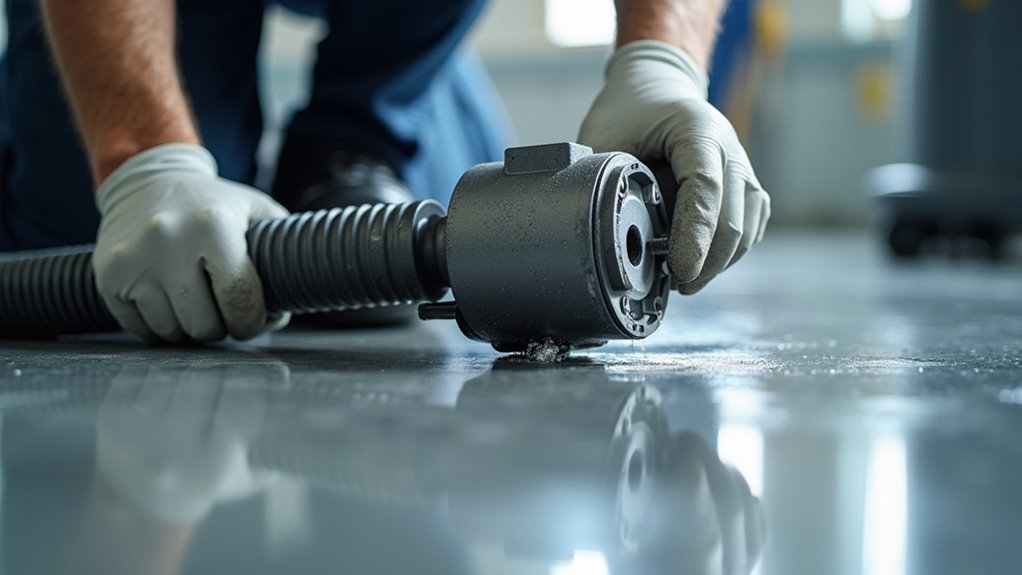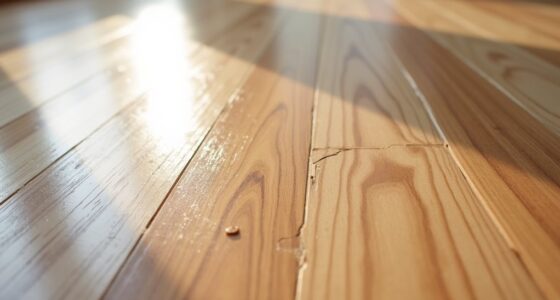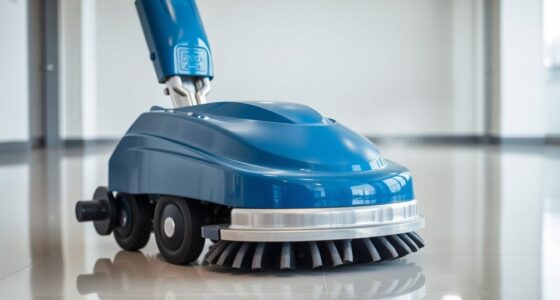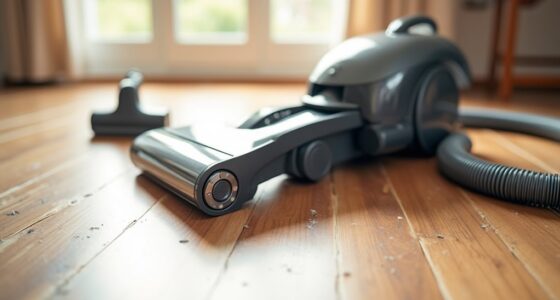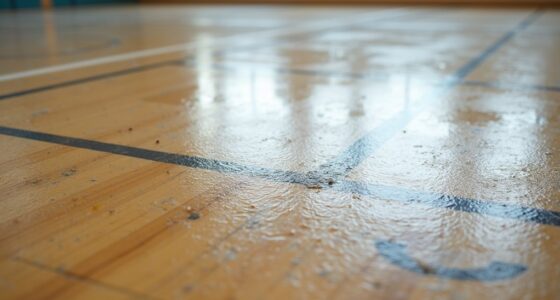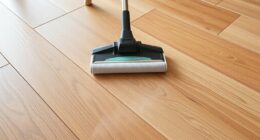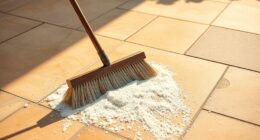If your vacuum isn’t picking up on polished concrete, start by inspecting the motor for overheating, unusual noises, or reduced suction, suggesting it may need cleaning or brushes replaced. Check the hose for tears, cracks, or obstructions that can block airflow. Make certain all connections are tight and the motor’s vents are clear. Keeping these components well-maintained can restore performance; keep going to discover more tips to troubleshoot effectively.
Key Takeaways
- Inspect the vacuum motor for overheating, unusual noises, or signs of wear, and clean dust buildup inside the motor housing.
- Check the vacuum hose for tears, cracks, or blockages, and clear any debris or obstructions inside.
- Ensure hose connections are secure and airtight to maintain proper suction.
- Examine the motor brushes for wear and replace them if necessary to restore motor efficiency.
- Regularly clean cooling vents and lubricate moving parts to prevent overheating and ensure smooth operation.

Maintaining a clean, polished concrete surface requires a reliable vacuum system, and that starts with checking your vacuum motor and hose regularly. When dust collection becomes ineffective, it’s often a sign that your system isn’t functioning properly. Dust can settle on your surface or be scattered back into the air if your vacuum isn’t performing at its best, which compromises the finish and creates health hazards. The first step is to examine the motor, as it’s the heart of your vacuum’s performance. A motor that’s not working efficiently may be overheating, making strange noises, or failing to generate enough suction. These issues usually point to dust buildup inside the motor housing or worn brushes that need replacement. Regular motor maintenance is vital—clean out any dust and debris, and guarantee the cooling vents aren’t blocked. Keeping the motor clean helps it run smoothly and prolongs its lifespan, preventing sudden breakdowns that could halt your work. Proper motor care can also prevent costly repairs and downtime, ensuring your polishing process remains uninterrupted.
Next, pay close attention to your hose. It’s often the first component to clog or develop leaks, which directly impacts dust collection. Inspect the hose for any tears, cracks, or blockages. Sometimes, debris or buildup gets lodged inside, reducing airflow and, consequently, suction power. Clearing out any obstructions assures your vacuum maintains maximum efficiency. Also, make sure the hose connections are tight and secure. Loose fittings can cause air leaks, decreasing suction and allowing dust to escape back into the environment. When you detect a loss in suction, it’s tempting to assume the motor is the problem, but often, the hose is the culprit. Replacing or repairing damaged hoses can restore ideal dust collection, improving your overall polishing results.
Beyond visual inspections, it’s important to listen to your vacuum. A sudden change in noise levels or a decrease in power often indicates a motor or hose issue. If the motor sounds strained or if airflow feels weak, don’t delay troubleshooting. Regularly scheduled motor maintenance—like checking brushes, cleaning internal components, and lubricating moving parts—can prevent unexpected failures. Similarly, routinely inspecting and replacing worn hoses keeps dust from bypassing your vacuum system altogether. Combining these practices ensures your vacuum maintains high suction power, which is essential for keeping the concrete surface spotless and professionally finished. When you stay vigilant about dust collection and motor maintenance, your polished concrete work will look consistently clean, smooth, and flawless, making your efforts worthwhile. Proper vacuum system maintenance is crucial for optimal performance and long-term durability.
Frequently Asked Questions
How Often Should Vacuum Motors Be Inspected for Optimal Performance?
You should inspect your vacuum motor at regular intervals, ideally every 3 to 6 months, to guarantee peak performance. Regular inspections help extend the vacuum motor lifespan by catching issues early. Check for unusual noises, overheating, or reduced suction. Consistent inspection intervals keep your equipment running smoothly, prevent costly repairs, and maintain effective cleaning, especially when working on polished concrete surfaces.
What Are Common Causes of Vacuum Hose Blockages?
Think of your vacuum hose as a garden hose connected to a sprinkler. Common causes of blockages include debris or tangled hose material, which can clog airflow. To clear these, inspect the hose thoroughly for obstructions, then perform blockage removal by carefully detaching and flushing out the hose. Regularly checking hose material and removing blockages guarantees your vacuum operates smoothly, preventing loss of suction and maintaining ideal performance.
Can Vacuum Motor Issues Affect Concrete Polishing Quality?
Yes, vacuum motor issues can affect concrete polishing quality by impairing dust collection. When the motor struggles or fails, dust and debris aren’t efficiently removed, leading to a less smooth, polished surface. Regular motor troubleshooting helps identify problems early, guaranteeing peak suction and consistent polishing results. Maintaining a healthy vacuum motor ensures dust is properly collected, which directly improves the quality and finish of your polished concrete floors.
Are There Specific Maintenance Tips for Extending Hose Lifespan?
Imagine a contractor who extended their hose’s lifespan by following simple maintenance routines. To boost hose durability, regularly inspect for cracks and blockages, and avoid sharp bends that stress the material. Store the hose properly, keeping it off the ground and out of direct sunlight. By maintaining your hose diligently, you can prevent damage and make sure it remains effective for your polishing projects, saving you time and costs in the long run.
What Safety Precautions Should Be Taken During Vacuum Motor Repairs?
During vacuum motor repairs, you should prioritize electrical safety by unplugging the machine before starting. Wear appropriate personal protective equipment, like gloves and safety glasses, to prevent injuries. Make certain the workspace is dry to avoid electrical hazards, and handle electrical components carefully. Always follow manufacturer guidelines and protocols to prevent accidents. If unsure, consult a professional to safely perform repairs and protect yourself from potential risks.
Conclusion
By regularly checking your vacuum motor and hose, you guarantee smooth cleaning for your polished concrete floors. Don’t wait until you notice a decline in performance—stay proactive. When you catch issues early, you save time and avoid costly repairs. Isn’t it worth taking a few minutes now to keep your equipment running perfectly? Keep these checks in mind, and your floors will stay flawless and your cleaning routine hassle-free.
